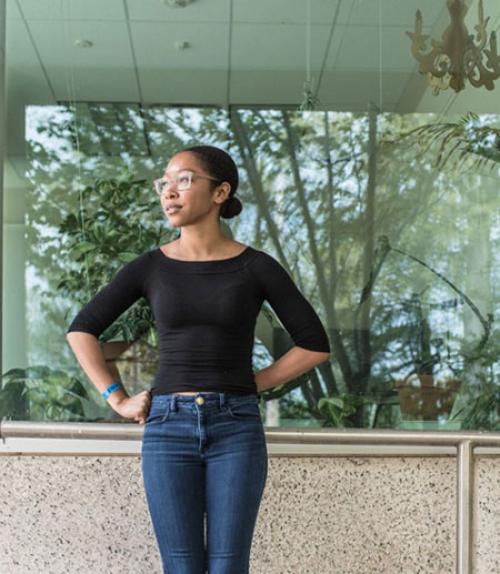Image: Dejah Powell ’18 outside Mann Library in May. Photo Credit Matt Hayes/CALS
Dejah Powell ’18 came to Cornell planning to study marine biology but quickly realized she wanted a wider interdisciplinary look at environmental and natural resource issues. Following her freshman year, she switched to the then-brand-new environmental and sustainability sciences (ESS) major in the College of Agriculture and Life Sciences (CALS).
“I wanted a quantitative and challenging academic major, and ESS had a solid foundation in biology, chemistry, physics, calculus,” Powell said. “But I also took classes in health, ethics, communication, and it was all connected through this lens of the environment. It gave me a really broad perspective.”
The perspective available to ESS students is now getting even broader. Starting this fall, the major will become a cross-college collaborative effort available to students in both the College of Arts and Sciences and CALS.
Cliff Kraft, who directs the cross-college major and is a professor in the Department of Natural Resources, said faculty in both colleges have long had research expertise on issues in environment and sustainability, spanning the disciplines from physical and biological sciences to social sciences and humanities.
In addition, faculty in both colleges have been involved in teaching classes and developing curriculum for the ESS major since the beginning, and it became clear that science and humanities students in Arts and Sciences also wanted to choose the major.
The new major also includes a brand-new concentration in humanities, opening opportunities for students to explore how art, literature, music and communication influence how humans perceive and respond to environmental issues. Bringing in the humanities perspective is crucial to helping society act on science, Kraft said, citing climate change as a pressing example.
“Scientists often fall into this trap of thinking, ‘Here is the answer; now the world will go out and do it.’ But that’s not how humans respond,” Kraft said. “I think there are instances where through literature, through art, through music you can actually better understand how people interpret the environment surrounding them than using either the social or natural sciences.”
Anindita Banerjee, associate professor of comparative literature, has been active in developing the new major. “The task of envisioning a sustainable future is a matter of human relations and communications and has to be put into a cross-cultural framework,” she said. “Students coming out of the ESS major will not be trained narrowly but will have a 360 degree, multidimensional perspective.”
The expanded ESS major resulted from an extensive community engagement process, which included students and faculty from CALS and Arts and Sciences. The new major is intended to expand a curricular focus that incorporates Cornell’s strengths in environmental sciences, social sciences and humanities, which are dispersed across multiple departments, colleges and majors. Deans of both colleges are making resources available to help faculty create new interdisciplinary courses in support of the ESS major. And together the two colleges are creating a new advising office, located in 117 Kennedy Hall, for the cross-college Program in Environment and Sustainability that now supports the ESS major. The office is scheduled to open in September.
There are six concentrations in ESS: the new environmental humanities concentration, along with the five previously available only for CALS students (environmental biology and applied ecology; environmental economics; environmental policy and governance; land, air and water resources; and an individualized, student-designed concentration). CALS majors will continue to earn a Bachelor of Science degree, while Arts and Sciences majors earn a Bachelor of Arts.
Students have already experienced the connections that can be made when combining the sciences with a humanities viewpoint. Jeff Fralick ’18 majored in ESS and, as part of a sustainability science course, was assigned to write a paper on art and sustainability.
“I had never really thought about the two terms together,” he said. But the exercise of viewing sustainability through the lens of photography strengthened his commitment to science and sustainability.
“Perhaps our best chance at ensuring a sustainable future for the planet could come from incorporating more humanities into science – making the problem appear closer to home, more personal, by understanding the history that has resulted in where we are today,” Fralick wrote.
Connecting environmental science and humanities will give Cornell students a more comprehensive understanding of the challenges facing humanity, Kraft said.
“There are a lot of majors that refer to interdisciplinary perspectives but then teach different courses in disciplinary silos,” Kraft said. “We want to teach by example, having people standing shoulder to shoulder teaching these multiple perspectives.”
Krisy Gashler is a freelance writer for the College of Agriculture and Life Sciences




